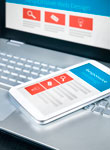
As a modern retailer, over the past few years you’ve been collecting email addresses from your walk-in customers, as well as people who find your web page, or connect with you via social media channels. You’ve gotten pretty good at sending out regular sales emails to help drive customers back into your store or onto your ecommerce web site, too. But what else can you do to squeeze out a bit of extra revenue and make a few more sales from your followers? A/B landing page testing is what you can do.
What’s an A/B test?
It’s simple – it’s a test you set up to send half of your customers an email that points to your regular landing page (A) on your web site, and the other half go to a new test page (B). The outbound email you send to everyone is identical — the only difference is where they land. Your test is to determine what elements on your store’s landing pages convert best into new sales. Many email service providers (ESP) have built in A/B split testing capabilities, so depending on which service you’re using, check out what your options are — and don’t be afraid to contact the ESP’s tech support group. Oftentimes a few minutes spent on an online tech support chat can help you set up a bunch of different functions you never knew were possible.
Set up your (A) panel
For example, let’s say you are running a sale on a gift bundle of products that includes a coffee mug, a T-shirt, and a package of gourmet cocoa. First, you build your outbound email and select your A/B split testing options to your targeted audience. Your ESP will split the audience, now you need to build out your test.
In your (A) version email, you tell your followers all about the great deal, and list an easy to find and easy to use call-to-action button that says BUY NOW. In this email you’ll embed the landing page link for your regular (A) product, using all the normal set-up procedures you already have in place.
Secondly, you set up your (A) landing page — the destination your shoppers will hit on your ecommerce site. Your web site no doubt allows you to display your products in a certain way, showing your store logo, an image of the product, pricing details, and a shopping cart to allow orders.
Set up your B panel
Take a good look at your A page and imagine what a first time shopper will see. Does the language and imagery on the landing page match your email? Does the email’s style and tone match the landing page’s style and tone? Is the image on the page small? Could it be bigger? How does your product description read? Is the font too big? Too small? Is it confusing? Do you have other offers on the page that are distracting? All of these different elements are testable – it’s your job to determine which element to test first, and then see if it has an appreciable difference in your response.
For this experiment, let’s say your email language and tone match your landing page, but the biggest thing shoppers see when they land on the sale page is a giant PAY NOW button, or Credit card fill-in boxes. That may be off-putting to some shoppers who want to see the product and check it out a bit before they give you their credit card information.
You decide to build a new landing page for your test where the product image is larger, and your credit card fill-in form drops down below the image, or is presented in a smaller font, that’s less intrusive. That’s your test page (B).
Embed this new landing page link in your (B) version email, and set the A and B emails to deploy at the same time. In order to get a true read, the emails must deploy together, otherwise you’re adding in a time element that can possibly impact your results. After the test goes out, read your results. Your overall open and click rate should be similar as both emails and the content was the same, so now you can read your ecommerce reports.
Results
How did the regular landing page do versus the new page? Did it generate more sales? Less sales? More customer inquiries? You will want to run this format test over several promotional cycles to get a good read on your results, especially if your email list is not huge.
If your results are close, consider repeating the test format over the course of a few months, or across a season to get a better idea of your audience’s preferences. Over time, you’ll see a trend that can result in your redesigning or changing small elements of your regular landing pages that will result in better sales overall.
Once your first test is done — keep going! Once you’ve found one element that improves your sales, look for the next one.
Landing Page Test Ideas:
- Message Voice: Does your email’s look, feel, and language match your landing page?
- Simplicity: Is the product image and description simple and clear? Is the price obvious? Is the shipping fee shown?
- Distractions: Do you have more than one element on your landing page distracting people from making the purchase?
- Call to Action: What’s the benefit to the shopper to completing the purchase?
- Trust: Is your site trustworthy? Is your checkout process secure? Are your terms clear?
- Images: Do your images load quickly and are they good quality? More images are not necessarily better. One good quality image may be just the ticket.
